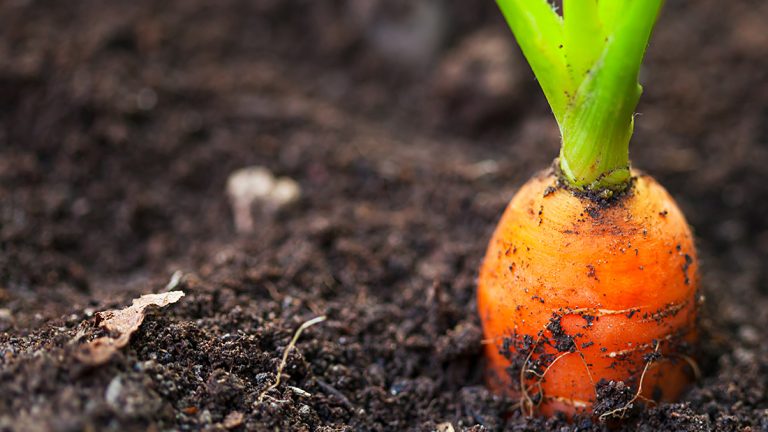- Mushrooms. It used to be really hard to get the conditions just perfect to grow mushrooms in your home. Add to that the very unappealing fact that you’re growing a fungus in your home, and even today the mushroom is overlooked. Now, though, there are so many kits on the market and so much more material out there on how to grow them that they’re a great option. This edible fungi is rich in vitamin B, phosphorus, potassium and copper. If you set them in the sun for 15 minutes before using them, they’ll carry a good dose of vitamin D along with them. The real plus for mushrooms is the fact that they grow so fast, continue to produce and usually can grow just fine in total darkness. That makes them essential to your apartment garden in a grid down situation. Consider having a dry kit stored in your prepper supplies.
- Carrots. Carrots need a deeper area to grow, but they will grow very well and very long in a 5 gallon pail from your local hardware store. In addition to having a decent nutrition density, you can eat the entire plant. Harvest some of the green tops while the root grows out. You can add them to salads or even make a pesto out of them.
- Potatoes. Until this season, I thought you needed a decent sized area to grow potatoes. This season, however, I’m easily growing them in a 5 gallon, plastic pail. One potato that turns a little green or has a lot of eyes because it’s past its prime, can be planted in a pail and yield you many more. Many will remember a recent Hollywood blockbuster where Matt Damon survives for months on potatoes. They’re a good source of starches and carbohydrates. Originating in South America, there are well over 4,000 different types of potatoes, 200 of which are sold in the United States. The ancestors of the Incans thrived on them over 10,000 years ago. Whatever you grow in the tuber family, don’t eat the leaves or any green fruits, as there is a toxin in them.
- Sweet Potatoes. Along with the potato, the sweet potato gets a solid mention. It has a slightly higher nutritional value than the average potato. It also is loaded with beta-carotene. The sweet potato is also easy to grow with the pail method, so having one type of tuber plant is a real plus. Tubers will keep for a long time if you keep them dry and out of direct sunlight. Don’t wash them when you harvest. Only wash them when you’re ready to prepare them to eat.
- Yams. Yams are not sweet potatoes, though many don’t know the distinction. For all the reasons tubers are good in your garden, Yams are right there too. The terms yam and sweet potato are often used interchangeably in grocery stores. But they are two different starchy vegetables that deliver different nutrient profiles. In most cases, the “yams” sold in grocery stores are actually orange-coloured sweet potatoes. Whatever you call your yams, know that they’re loaded with nutrients you need and easy to grow.
- Dandelion. Another weed makes my list of 25 here. The dandelion was once a staple food in the American diet. People actually cultivated them right out of their lawns. They are loaded with vitamins a, k, and the mineral iron. It grows like a weed so it will easily grow in your apartment garden. The flowers, leaves, roots, the whole plant can be eaten and there are a number of recipes online from salad greens, to roasted for a coffee substitute, to dandelion wine.
- Chamomile. While not a nutritional powerhouse, chamomile is easy to grow. In fact, it’s said the rougher you are with the plant the better it tends to grow, so you don’t have to treat it with kid gloves. While not devoid of nutrition, it is known for its calming effects, so it’s worthy of this list.
- Sunflowers. If you can handle the height requirements of sunflowers, they grow easily on porches. The entire plant from root to flower is edible. Typically, we only think of the seeds. The seeds are a very good source of fats and proteins. Sunflowers can also serve as trellising for your beans and peas.
- Peppers. In the interest of time, I won’t list out all your options in the pepper category. There are too many. Whether you grow a smoky and sweet Marconi or bird pepper variety it doesn’t matter. Peppers are loaded with carbohydrates, vitamin c, b6, a, k, e, potassium, and folate. The indoor or apartment gardener has an advantage over the outdoor gardener with pepper plants. Insects love to eat pepper plants, but they have a much harder time getting to your third floor balcony. Peppers are a great patio container plant with a very high yield and great nutrient density.
- Kale. Kale grows very well and can be harvested slowly over an entire growing season. It deserves a spot on the list for that reason and because it has a good nutrient density score and it is easy to grow. I could have just as easily put mustard greens in here for the same reasons. One big advantage for the urban gardener for this plant is your growing area, even if out on your balcony, will likely not have slugs or too many insects that would feast on these plants in your typical garden.
- Turnips, beets, and radishes. I’ll finish our list of 25 with these three root vegetables. Turnips, beets, and radishes grow easily and you can eat the entire plant. They have a high nutrition value, so they deserve consideration for your micro survival garden. You can easily harvest the leaves throughout the season, so you can eat the whole plant over a long period of time.






